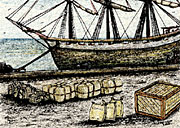Naval Shipyard
 |
| By 1750 Philadelphia had overtaken Boston as the center of colonial shipbuilding. |
Sure, the U.S. Navy got its start in the shipyards of Philadelphia, but the hoagie?
It's true, but before the story of the hoagie's 20th century birth, turn back the clock more than a century earlier. The first U.S. Naval Shipyard opened in Philadelphia in 1801, just two years before Meriwether Lewis arrived in the city. The choice of Philadelphia made sense.
Soon after William Penn landed in Philadelphia in 1682, settlers began building small ships. Within a decade locally built ferryboats connected Philadelphia with Cooper's Point in Camden, NJ. By 1750 Philadelphia had overtaken Boston as the center of colonial shipbuilding. There were 12 shipyards along a one-mile stretch of the Delaware. The boats of the time were made of wood and powered by sail. Because of the vast supply of ash and cedar in "Penn's Woods," ships built in Philadelphia cost less than those in England.
When the Revolutionary War broke out, the colonial forces needed a navy. One ship of the line—a warship large enough to have a place in the line of battle—and four frigates were built by authority of the Continental Congress.
Joshua Humphreys owned a shipyard in South Philadelphia. He was the principal architect of the new navy. The frigate Randolph, launched in 1778, is generally considered the first vessel built for the new nation. However, Lt. John Paul Jones of the frigate Alfred hoisted the first American colors on Dec. 23, 1775, on the Delaware.
In 1794 Congress approved construction of "a naval armament for the United States" and in 1799 appropriated funds to create the U.S. Navy's own shipyards in Philadelphia. In the next two years Humphreys' yard and adjoining parcels were acquired for the Philadelphia Naval Shipyard.
The yard prospered, but the Civil War had convinced Congress of the need for a larger shipyard in Philadelphia. In 1875 the Navy began operating at its new yard at the confluence of the Delaware and Schuylkill rivers.
Private shipyards continued to boom as well on the Delaware during the 19th century. They built most of the iron ships that overtook the old wooden ships at the outset of the Industrial Revolution. The nation's first true oil tanker was built in these yards for Standard Oil in 1888.
World War I brought plenty of business for all the yards. And that's where the hoagie comes in.
Demand for ships was so great during World War I that the nation's largest shipyard was built from scratch in 10 months on Philadelphia's Hog Island. The yard employed 35,000 people, whose fast-food luncheon sandwiches took their name from the island. Hoagies far outlived the yard, though. It closed in 1921 after building 122 ships. Runways for Philadelphia International Airport now cover the site.
The Philadelphia Naval Shipyard blossomed during World War II when 47,000 people worked there. It produced its last ship during the 1970s, and in 1996 the yard closed. The last station log entry was this: "Shipyard commander orders the watch secured and Philadelphia Naval Shipyard closed; secured the watch, Philadelphia Naval Shipyard is closed, no further entries this log."
< previous | next > | 


